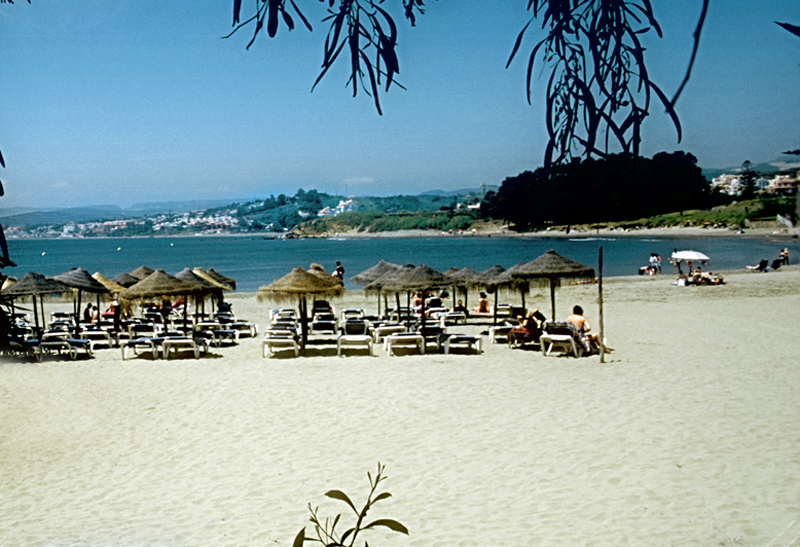By Denise Mattia
 You’re on the verge of slipping into the chronic lifestyle of leisurely afternoons with a café con leche, evenings in bares de copas (cocktail bars), late-night dinners and midnight orchestral venues in the land of sun and siestas. But before your thoughts turn to tapas and a glass of Manilva (a delicious white wine from the Casares and Manilva region in Malaga), remember in Malaga, there are 20 museums (including the new, stunning Picasso Museum) from which to choose, centuries-old Roman, Moorish and Spanish ruins to visit, and the entire Costa del Sol to explore.[slideshow id=28]
You’re on the verge of slipping into the chronic lifestyle of leisurely afternoons with a café con leche, evenings in bares de copas (cocktail bars), late-night dinners and midnight orchestral venues in the land of sun and siestas. But before your thoughts turn to tapas and a glass of Manilva (a delicious white wine from the Casares and Manilva region in Malaga), remember in Malaga, there are 20 museums (including the new, stunning Picasso Museum) from which to choose, centuries-old Roman, Moorish and Spanish ruins to visit, and the entire Costa del Sol to explore.[slideshow id=28]
Nine miles southwest of Malaga lies Marbella, a beach destination favored by Europeans, Saudis and Americans. Generally not considered an area for scuba diving, the dive sites – either from shore or 30 minutes away by boat – to the west, including Gibraltar – are home to a variety of marine life.
At locations close to shore, a cargo ship, a French galleon and sloping reefs, divers can expect to see sea stars, basket stars, anemones, spider crabs, seahorses, eels, octopus, dolphins and cuttlefish. In addition to these, some of the largest fan worms in the Mediterranean can be found in the sand. Pale, feather-like appendages spread out ten inches in all directions to capture plankton and draw nourishment into parchment-colored tubes. Farther out at sea, divers encounter pelagics such as turtles and moonfish. Occasionally pilot whales are sighted as well.
Less than two miles from Marbella is the gleaming white village of San Pedro Alcántara. Mature residents climb the narrow streets easily, while visitors, unused to this rugged hilly interior, “chug” along, catching their breath in one of the bodegas that dot the village. Charley’s tapas bar displays pans of wonderful local tuna, shrimp, conch and goat tapas. Farther north, the mountain village of Benahavis is known for golf and (surprise!) tapas bars and restaurants. The Grand Hotel Benahavis is affordable, if reservations are made on line, and the spa provides a welcome respite to all travelers. At around 10 pm, La Sarten comes alive with tourists and locals alike. Here, serious garlic is served with succulent roasted pork.
Worthwhile is a detour up the winding mountain to Ronda. The municipality is where the Romero family made bullfighting into an “art form.” Ronda is also where Ernest Hemmingway spent many summers and wrote about the beauty of the countryside and bullfighting traditions.
At the edge of an isolated precipice west of Marbella are the remains of a Moorish stone citadel, a reminder that 1300 years ago the Arab armies of Islam conquered much of Spain. The Atalaya, a Moorish word meaning watchtower, stands at a tip in Estepona facing seaward and affords a panoramic view of the coastline and, on clear days, a view of Morocco as well.
Colorful ceramics, made and hand-painted in Spain, can be found at the market on Sundays At Playa del Cristo one of almost four miles of beaches surrounding the port of Estepona. Most of the clothing and shoes come from the Orient, but the stalls are colorful and the area is charming. From April until November bar/restaurants are open on the beaches.
Farther west is Gibraltar. An early arrival insures a shorter time entering the “Rock,” but there’s almost always a long queue returning. Spanish customs’ officials sometimes thoroughly check passengers who come to shop in this tax-free British overseas territory. Here, if pub-crawling (fish and chips replaces tapas) and gaming are less desirable than sightseeing, there are tours into a few of the 140 caves, some dating back to the first century, in addition to a public market, the colorful changing of the guard (several times a day) and a museum, church and mosque to visit. There are also three shipwrecks in the harbor for underwater exploration.
Along with much of the industrialized world, profitability has come under pressure. The challenge today is to keep up with luxury demands by developing important sub-markets such as golf, incentive and conference visits, rural tourism, ecotourism, winter sports and city and cultural attractions, while maintaining a way of life that appeals to every visitor who comes to Costa del Sol.
About Denise Mattia
A writer and photographer, Denise Mattia’s works are published nationally and internationally and include all aspects of leisure travel: art , culture, resorts, spas, food and wine and sports’ activities. She's the founder of the soon to be launched Yum-Yum-Traveler, a site devoted to reviewing restaurants in addition to her travel articles from around the world. She lives and works in Manhattan, where she was born.
- Web |
- More Posts (91)
